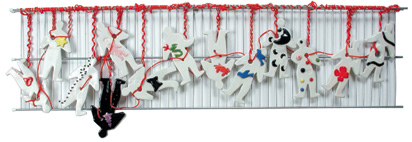-
It When we deal with art in Israel, we must ask the question: Is there
an “Israeli art,” or is it simply works of art that are made in Israel
but could have been done in any other place on the globe? The fact that
Israel is in Asia near Africa but connected to the West (Europe and the
U.S., especially in cultural matters) and that most people living in
this country were born all over the world, make the question even harder
to solve. There has always been a conflict in Israeli art between the
need to develop art that combines internationally and the need to
express a connection unique to the land and nation.
In the first decade of the Israeli state (1950-1960), we can find two
mainstreams in Israeli art: one concerned with nature and landscape but
in a non-figurative or nearly abstract style that was connected to
universal painting; the other more social and national. Only very few
were not part of these two groups and dealt with Jewish mystical themes.
In the sixties, there was estrangement from nature and traditional
painting and sculpture. Artists were dealing more with photography,
performance, and video art in political and personal contexts. These
tendencies developed in the seventies, where more works connected to
geo-political matters together with personal and artistic identity,
usually in conceptual and minimal art.
The phenomenon of a “return to painting,” color, and expression occurred
in the eighties in Israel and in other art centers in the world, as seen
in such exhibitions as “A New Spirit in Painting” in Britain, and
“Zeigeis” in Germany. There was more connection to art everywhere on the
globe and the feeling that everything is possible, everything is allowed.
In the nineties, installation and video art dominated the major
international exhibitions – for instance, the Venice “Biennale” and the
“Documenta” in Kassel - and caused painting to be pushed aside in
Israel, too. We can also find in this period traces of the need to be
connected to the spiritual, mystical, and hallucinogenic tendencies.
-
|
In recent years, painting and sculpture are back in the center. However,
the works do not have a clear and defined stylistic character. Artists
mix various mediums, techniques, and disciplines - from painting to
photography, video, installation and sculpture, from figuration and
realism to abstraction: Basil Frank, Varda Carmeli mix photography and
sculpture; David Gerstein, Gad Ullman, and Aviva Beigel mix painting and
sculpture; Eduard Grossman, Yael Segev, Rosi Shaham and Liana
Hollander-Gross move gently from figurative to abstract; Gad Ullman uses
photographed images (old streets of Tel Aviv) from the popular media;
Dudo Gerstein deals with cars and buildings from the world of computers;
and from the news, Basil C. Frank images “The Wailing Wall.”
There is also the use of different cultural worlds: Eduard Grosman
combines the Eastern culture of text figures and calligraphy; Vara
Carmeli uses the egg as a symbol of birth; and Yona Levi refers to early
Egyptian grape-harvesting and wine-drinking from Ancient Greece.
We see all kinds of references to science and nature: Uri de Beer uses
spiral forms inherent to the organic and natural world; Varda Carmeli
employs organic material – eggs; Sara Tandet-Ron deals with organisms
and adjacent molecules, the raw material that is the origin of every
living cell; Yona Levi combines a philosophical and scientific approach.
And there is the use of religious and historical national icons: Eduard
Grossman makes “The Legends,” a biblical and mythological interpretation
in light and color, using Hebrew letters and archaeological elements;
Gad Ulman and Aviva Beigel use the “Magen David” Jewish sign; Uri de
Beer deals with Jewish mystic tradition and spiritual dimensions.
There are no themes that can not be included: Sara Tandet-Ron’s
personal, feminine themes, touching life and death; Erica Weiss’s
revealing of her own soul; Varda Carmeli’s private world; the appearance
of sickness and pain in Aviva Beigel’s cosmos; Dita Lyron’s women,
concerning fertility and pregnancy.
The last tendency we can find is the return of the pleasure principal.
Even if some of the works deal with hard and loaded themes, it is also
allowable to “have fun,” to amuse. Yael Segev’s works combine humor and
optimism, animals and human figures; Dudu Gerstein’s sculptures approach
the child in every one of us; and Aviva Beigel amuses herself with
cookie shapes taken from the child’s world, such as hearts and
butterflies.
Contemporary art in Israel is not necessarily “Israeli art.” Looking
upon the variety of the works, one can not find a special factor that
identifies them exclusively as Israeli. They appear as if they could
have been done anywhere, and today, when the technological era provides
a direct and virtual access everywhere and the world is “a small global
village,” the Israeli artist is also an international artist.
-
Aviva Beigel
|
